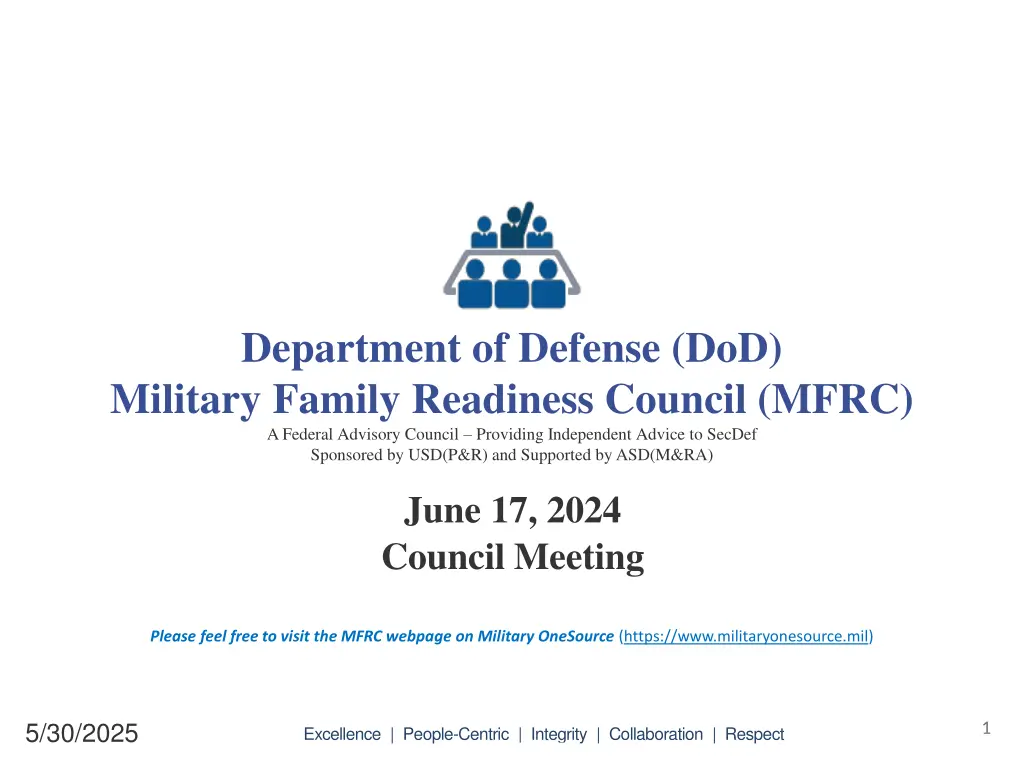
Military Family Readiness Council Meeting Summary and Agenda June 17, 2024
Explore the agenda of the Military Family Readiness Council meeting held on June 17, 2024. Topics discussed include the Military Health System, provider shortages, reimbursement models, and more. The focus is on enhancing healthcare services for military families. Visit the MFRC webpage for details.
Download Presentation

Please find below an Image/Link to download the presentation.
The content on the website is provided AS IS for your information and personal use only. It may not be sold, licensed, or shared on other websites without obtaining consent from the author. If you encounter any issues during the download, it is possible that the publisher has removed the file from their server.
You are allowed to download the files provided on this website for personal or commercial use, subject to the condition that they are used lawfully. All files are the property of their respective owners.
The content on the website is provided AS IS for your information and personal use only. It may not be sold, licensed, or shared on other websites without obtaining consent from the author.
E N D
Presentation Transcript
UNCLASSIFIED Department of Defense (DoD) Military Family Readiness Council (MFRC) A Federal Advisory Council Providing Independent Advice to SecDef Sponsored by USD(P&R) and Supported by ASD(M&RA) June 17, 2024 Council Meeting Please feel free to visit the MFRC webpage on Military OneSource (https://www.militaryonesource.mil) 1 5/30/2025 Excellence | People-Centric | Integrity | Collaboration | Respect UNCLASSIFIED
UNCLASSIFIED Department of Defense (DoD) Military Family Readiness Council (MFRC) A Federal Advisory Council Providing Independent Advice to SecDef Sponsored by USD(P&R) and Supported by ASD(M&RA) Agenda Military Family Readiness Council Meeting June 17, 2024 (1300-1530 Eastern Time Zone) Opening Remarks 1300 1315 The Military Health System Stabilizing and Improving Specific Mitigation Network Provider Shortages Increasing Reimbursement Rotator Model Discussion Break 1400 1515 Closing Remarks Chair/DFO 1530 Public Meeting is Officially Closed 2 5/30/2025 Excellence | People-Centric | Integrity | Collaboration | Respect UNCLASSIFIED
UNCLASSIFIED UNCLASSIFIED Military Family Readiness Council: Focus on Medical Office of the Assistant Secretary of Defense for Health Affairs Excellence | People-Centric | Integrity | Collaboration | Respect UNCLASSIFIED
UNCLASSIFIED UNCLASSIFIED Framing Today s Discussion Review the organizational construct and key data points of the Military Health System Summarize recent and on-going reforms to the Military Health System Explain short term mitigation to constrained access to care for military families Excellence | People-Centric | Integrity | Collaboration | Respect UNCLASSIFIED 4
UNCLASSIFIED UNCLASSIFIED The Military Health System Excellence | People-Centric | Integrity | Collaboration | Respect UNCLASSIFIED 5
UNCLASSIFIED UNCLASSIFIED What is the Military Health System? As summarized by the Congressional Research Service DOD administers a statutory health entitlement through the Military Health System (MHS). The MHS offers health care benefits and services through its TRICARE program to approximately 9.5 million beneficiaries composed of servicemembers, military retirees, and family members. Health care services are available through DOD- operated hospitals and clinics, referred to collectively as military medical treatment facilities (MTFs), or through civilian health care providers participating in the TRICARE program. Excellence | People-Centric | Integrity | Collaboration | Respect UNCLASSIFIED 6
UNCLASSIFIED UNCLASSIFIED Key Data Points Summarized from the Fiscal Year 2023 TRICARE Annual Evaluation 9.5 million worldwideb Total Beneficiaries a Unless specified otherwise, this report presents budgetary, utilization, and cost data for the Defense Health Program (DHP)/UMP only, not those related to deployment or funded by the Line of the Services. MILITARY FACILITIES DIRECT CARE SYSTEMc Inpatient Hospitals and Medical Centers 45 (31 in U.S.) b Department of Defense (DoD) health care beneficiary population projected for the end of FY 2022 is 9,489,182, rounded to 9.5 million. This projection is based on the DoD Comptroller s Budget End Strength, the DoD Actuary s forecast of the retiree population, and the family members per sponsor from the Defense Manpower Data Center Defense Enrollment Eligibility Reporting System (DEERS) as of January 2023. Ambulatory Care and Occupational Health Clinicsd 566 (466 in U.S.) Dental Clinics 117 (94 in U.S.) Military Health System (MHS) Defense Health Program Personnel 127,511 Military 70,116 c Military medical treatment facility (MTF) clinic count includes occupational health, community-based, embedded behavioral health, Active Duty troop, centers of excellence, and joint DoD-Department of Veterans Affairs (VA) clinics, and excludes leased/contracted facilities and Aid Stations. Military facility counts are that of the number of facilities based on the Defense Medical Information System Identifiers ID, not clinical functions Source: Defense Health Agency (DHA)/Resources & Management (J-1/J-8)/Budget and Execution and Programming Divisions, 1/26/2023. 26,404 Officers 44,914 Enlisted 57,395 Civilian (including Foreign National) CIVILIAN RESOURCES PRIVATE SECTOR CARE SYSTEMe Network Primary Care, Behavioral Health (BH), and Specialty Care Providers (i.e., individual, not institutional, providers) 1,163,560 Network BH Providers (shown separately, but included in above) 164,245 d The projected increase in ambulatory clinics for FY 2023 is largely administrative in nature to ensure system alignment with MHS GENESIS Patient Care locations. The policy reinforcement has come from two different directions: (1) Defense Medical Information System Identifiers (DMIS IDs) table alignment with MHS GENESIS to resolve issues in clerk/patient appointing and (2) aligning overhead costs to a building or function to better reflect the cost of care (delineating buildings on the DMIS table that don t fall under a campus concept). TRICARE Network Acute Care Hospitals 4,880 BH Facilities 2,295 Contracted (Network) Retail Pharmacies 42,500 Contracted Worldwide Pharmacy Home Delivery Vendor 1 e As reported by the managed care support contractors (MCSCs) for contracted network provider and hospital data, 12/19/2022; and TRICARE Dental Program Section, Health Plan Execution and Operations for dental provider data, 3/1/2023. TRICARE Dental Program (TDP) (for Active Duty families, Reserve members and their families) Over 1.79 million covered lives in 756,000 contracts Over 80,300 total dentists, including: 62,144 general dentists and 18,191 specialty dentists f UMP presented here includes direct and private sector care funding, military personnel, military construction, and the MERHCF ( Accrual Fund ). Budget and expense data from DHA/Resources & Management Directorate (J-8)/Budget & Execution Division, as of FY 2023 Request. TDP Network Dentists Total Requested FY 2023 Unified Medical Program (UMP) (Including Projected Trust Fund Receipts) $58.38 billionf Projected Receipts from Medicare-Eligible Retiree Health Care Fund (MERHCF) Trust Fund $9.74 billion Excellence | People-Centric | Integrity | Collaboration | Respect UNCLASSIFIED 7
UNCLASSIFIED UNCLASSIFIED Key Data Points (cont.) Summarized from the Fiscal Year 2023 TRICARE Annual Evaluation Excellence | People-Centric | Integrity | Collaboration | Respect UNCLASSIFIED 8
UNCLASSIFIED UNCLASSIFIED Stabilizing and Improving Excellence | People-Centric | Integrity | Collaboration | Respect UNCLASSIFIED 9
UNCLASSIFIED UNCLASSIFIED Timeline of Major Reforms Twenty-five years of change in the MHS from 1998-2023 TRICARE Management Activity established as a field activity (1998) Joint Task Force National Capital Region (2007) Secretary of Defense directs the MHS Review (2014) DoD begins deploying a new electronic health record (2018) 1998 2023 5th Base Realignment and Closure (BRAC) consolidated Water Reed Army Medical Center and National Naval Medical Center Bethesda (2005) DHA replaces TRICARE Management Activity and Joint Task Force Capital Medicine (2011-2013) DHA authorities expand to manage MTFs and DTFs, research and development, public health, and education and training (2017-Present) Excellence | People-Centric | Integrity | Collaboration | Respect UNCLASSIFIED 10
UNCLASSIFIED UNCLASSIFIED Directives for 2024 From the Deputy Secretary memo Stabilizing and Improving the Military Health System Requirements Determination (i.e., mission analysis) Comprehensive review of all medical manpower and staffing. Add medical force generation to the Defense Readiness Reporting System (DRRS). Update DoD policy to reflect these directives. Military Manpower Primarily prioritize assignment of uniformed medical and dental personnel to MTF/DTFs. Business rules to more holistically adjudicate risk to MTFs, DTFs, and operational medical readiness. MTFs and DTFs become the primary choice of assignment absent specific, validated operational and training requirements identified by the Service Secretary of exigent circumstance. Civilian Manpower Prioritize implementation of chapter 74 of title 38, U.S. Code, authorities to improve recruitment and retention of health care personnel. Excellence | People-Centric | Integrity | Collaboration | Respect UNCLASSIFIED 11
UNCLASSIFIED UNCLASSIFIED Specific Mitigation Excellence | People-Centric | Integrity | Collaboration | Respect UNCLASSIFIED 12
UNCLASSIFIED UNCLASSIFIED Network Provider Shortages TRICARE, like Medicare and other health plans, is opt-in for providers and health care organizations. The current Managed Care Support Contractors are meeting all contractual requirements for network adequacy Medical provider shortages in the local communities have been linked to high medical liability insurance, driving them to practice in neighboring states (e.g., TX, CO, and AZ). In the next TRICARE Managed Care Support Contract (T-5), enrolled beneficiaries will have broader access to telehealth to mitigate local shortages. Improving reimbursement rates and opening the aperture on value-based care arrangements will also increase access to care in the longer term. Excellence | People-Centric | Integrity | Collaboration | Respect UNCLASSIFIED 13
UNCLASSIFIED UNCLASSIFIED Increasing Reimbursement The next generation TRICARE Managed Care Support Contacts (T-5) changes to cap on reimbursements to incentivize providers and health delivery systems to stay in or even join the TRICARE network. T-5 introduces Alternate Payment Models (APMs), which reward health care providers for delivering high quality and coordinated care. APMs can apply at the population level or by specific health condition o Pay for Reporting o Pay-for-Performance o Supplement fee-for-service (FFS) payments with shared savings and/or downside risk o Replace some or all FFS payments with capitation or a similar population- based, two-sided risk arrangement Locality Based Waivers carry-over from T-2017 o If it is determined that access to specific health care services is severely impaired, higher payment rates could be applied to all similar services performed in a locality Excellence | People-Centric | Integrity | Collaboration | Respect UNCLASSIFIED 14
UNCLASSIFIED UNCLASSIFIED Rotator Model A circuit rider for manning assists The Defense Health Agency is leveraging its reorganization into Defense Health Networks to prioritize rotator/circuit rider opportunities to maximize available capacity across the military medical treatment facilities (MTFs). Impending OSD-level policy will streamline rotator/circuit rider requests. Requests Assistance Manages Request Backstops Request Defense Health Network A Directs resources within its network Coordinates across networks Defense Health Network B Excellence | People-Centric | Integrity | Collaboration | Respect UNCLASSIFIED 15
UNCLASSIFIED UNCLASSIFIED Discussion Excellence | People-Centric | Integrity | Collaboration | Respect UNCLASSIFIED 16
UNCLASSIFIED UNCLASSIFIED Discussion Items Discussants Principal Deputy Assistant Secretary of Defense for Health Affairs Chief of Staff, Office of the Assistant Secretary of Defense for Health Affairs Topics for Consideration Relationship between military family readiness and routine health service delivery Tradeoff and integration between operational medical readiness and health service delivery Impact of national health care personnel shortages on military family readiness Excellence | People-Centric | Integrity | Collaboration | Respect UNCLASSIFIED 17






















